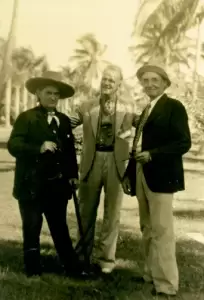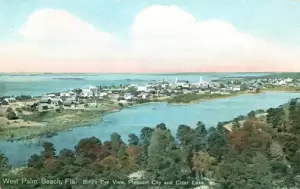The Styx: Removal

Several men owned and collected rent on portions of the land under the Styx community, including Henry Maddock, E.M. Brelsford, and James M. Munyon. Each of these landlords dealt with many tenants, other property owners, local and state officials, and usually an agent to represent his interests. The local newspaper, The Tropical Sun, reported the ongoing efforts of the white community to improve or remove the conditions in the Styx, revealing a complex (if one-sided) view of the situation:
Sanitation conditions had greatly improved since Eugene F. Haines, Justice of the Peace of the Thirteenth District, had taken over as agent for James Munyon. Haines issued orders to the blacks to “observe perfect sanitary laws and keep their premises clean and tidy or pay a $10.00 fine."
The Tropical Sun, May 1903
Four blacks were arrested for operating a “blind tiger” [or “speakeasy,” where alcoholic beverages were sold illegally]. Another man, apparently white, was arrested for the same reason across the lake on Banyan Street.
The Tropical Sun, October 1903
“East Side” property owners [Palm Beachers] Senator Elisha Dimick, Thomas Tipton “T. T.” Reese, Enoch Root, and Harry Redifer asked the West Palm Beach Board of Trade for help with conditions at the Styx. Flagler and others, they said, had also promised, “to rend what aid they could.”
The Tropical Sun, January 1904

Senator Dimick (chair of the East Side owners) had approached the state health officer, who said the local officer was authorized to handle the problem. Officers had already come from two other areas and presumably reported to Tallahassee, but nothing had changed. Dimick believed, “if the health officer was to insist that the property owners put in sewers it would have to be done or else remove the buildings.” Dr. Henry J. Hood, chair of the West Side (West Palm Beach) owners and supervisor of the local health officer, Dr. Richard B. Potter, offered to speak with him. Dr. Hood also acted for E. M. Brelsford, who he said would evict his tenants if others did. Representatives for Sidney Maddock, [unnamed] Russell, and Munyon were sure their clients would agree. A three-man committee was organized to act as liaison with the Styx residents.
At a subsequent meeting, Enoch Root, the Palm Beach postmaster, called conditions “bad beyond all powers of imagination.” He described the Styx as “hundreds and hundreds of unsightly huts, some of them but little more than shoeboxes, all jumbled up together, and with no system of sewerage, and the filth was allowed to remain. [M]oral conditions were such as to cause all decent people to shudder [with] scores of houses of ill-fame, blind tigers and other dens of iniquity.”
The Tropical Sun, February 1904
All property owners were said to have agreed to “do what was best.” Munyon authorized George Currie (then Dade County treasurer) to have a deputy serve his 150 tenants with 30 days’ notice to remove their dwellings. Maddock said he would follow suit when the season ended. Guy Metcalf had given 30 days’ notice to Russell’s tenants, not only to vacate, but also “to remove their ‘shacks.’” The unnamed purchaser of Russell’s property, Metcalf said, intended “to make a cleaning out of all [illegible] element, and conditions that have brought about so much fear of epidemic.”
In 1910 T. T. Reese convinced his employers, brothers Edward R. and John R. Bradley, to purchase Munyon’s land in the Styx, adjacent to their existing property, from the Beach Club northward 264 feet to John Bradley’s cottage, and from the lake to the ocean. The plan for that summer, The Tropical Sun reported, was to remove all the old shacks on the Bradley property, fill in the marshy sections, remove “ugly barn-like buildings” along the water’s edge that were “damaging the value of contiguous estates,” and add a road along the lakefront.
There was no mention of the residents, who apparently had relocated for the most part about 1906 to the all-black Northwest neighborhood of West Palm Beach, which had been established since 1894. According to the Palm Beach Daily News:
Many negroes had been allowed to put up “topsey-like” houses, [which] have seen their best days [and] will disappear within the next few months. The entire tract will be leveled, filled in, and ornamental trees … will be planted. [T]hree large and commodius [sic] villas … will be built of concrete and Miami stone.
Palm Beach Daily New

The rest of the Styx residents were not asked to leave until 1912, as the Bradleys developed their land into the town’s second subdivision, Floral Park. That year Pleasant City, established in 1905, was created. A 1913 ad in The Tropical Sun advertised its remaining lots for sale by Currie Investment and Title Guaranty Company: “This is a high class colored subdivision north of town. Four hundred lots have already been sold and we have about 75 more yet for sale from $150.00 up.” Currie chose ‘pleasant’ names for the streets: Beautiful, Comfort, Merry, Cheerful, Contentment—even an Easy Street. Present day Pleasant City is bordered on the north by Northwood Road, on the south by 15th Street, on the east by Dixie Highway, and on the west by the FEC railroad tracks.

